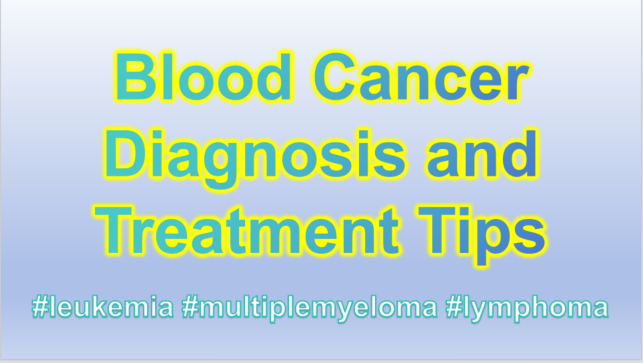 Blood Cancer – Diagnosis and Treatment Tips
Blood Cancer – Diagnosis and Treatment Tips 

Blood Cancer
Blood cancer, encompassing types such as leukemia, lymphoma, and multiple myeloma, represents a significant health challenge in regions like Southeast Asia and India. These hematologic malignancies arise from blood-forming cells and can impact the bone marrow, blood, and various organs. The increasing prevalence of these diseases is concerning, yet advancements in diagnosis and treatment provide hope for patients.
## Understanding Hematologic Malignancies
 Hematologic malignancies include a variety of cancers such as:
Hematologic malignancies include a variety of cancers such as:
– **Leukemia**: Cancer of the bone marrow that leads to the overproduction of abnormal white blood cells.
– **Lymphoma**: Affects the lymphatic system and includes #Hodgkin and #nonHodgkinlymphoma.
– **Multiple Myeloma**: Cancer that forms in plasma cells, affecting the production of antibodies.
 The causes of these conditions are multifactorial, involving genetic factors, immune dysfunction, exposure to environmental toxins, and lifestyle choices. For instance, a diet high in processed foods, sedentary behavior, and high stress levels can contribute to an increased risk of developing these cancers.
The causes of these conditions are multifactorial, involving genetic factors, immune dysfunction, exposure to environmental toxins, and lifestyle choices. For instance, a diet high in processed foods, sedentary behavior, and high stress levels can contribute to an increased risk of developing these cancers.
## The Rising Incidence of Blood Cancer
The incidence of blood cancers is on the rise globally, particularly in countries with aging populations. In Southeast Asia and India, there has been a noticeable increase in cases of leukemia and lymphoma, necessitating better awareness and improved healthcare infrastructure.
## Diagnosis: Early Detection is Key
Early diagnosis is crucial for successful treatment outcomes. Patients experiencing symptoms such as unexplained fatigue, frequent infections, easy bruising, or swollen lymph nodes should seek medical advice promptly. Healthcare providers may utilize blood tests, bone marrow biopsies, and imaging studies to diagnose these conditions accurately.
## Treatment Advances: A Diverse Approach
Recent years have seen significant advancements in the treatment of hematologic malignancies, offering patients more options than ever before:
1. **Combination Chemotherapy**: Despite potential side effects, combination chemotherapy remains a cornerstone treatment. New regimens are being developed that combine traditional cytotoxic drugs with targeted therapies and immunotherapies to enhance efficacy and reduce toxicity.
2. **Targeted Therapies**: Drugs that specifically target cancer cell mutations or characteristics are revolutionizing treatment. For example, *Gleevec*, the first targeted therapy, has dramatically improved survival rates for chronic myeloid leukemia (#CML).
3. **Monoclonal Antibodies**: Often dubbed “biological missiles,” these treatments target specific proteins on cancer cells, allowing for more precise treatment with fewer side effects.
4. **Hematopoietic Stem Cell Transplantation**: This procedure remains one of the most effective treatments for certain types of blood cancer, especially when other treatments fail.
5. **Immunotherapy**: This approach harnesses the body’s immune system to fight cancer. Techniques like CAR-T cell therapy, which modifies a patient’s T cells to attack cancer cells, have shown promising results in treating various hematologic malignancies. China is at the forefront of CAR-T cell therapy research and application, particularly in treating hematologic malignancies. CAR-T therapy involves extracting a patient’s T cells, modifying them to specifically recognize and attack cancer cells. Clinical research and applications in China have shown remarkable effectiveness in treating leukemia, lymphomas, and multiple myeloma. Some studies indicate that patients receiving CAR-T treatment experience significantly higher long-term survival rates and lower recurrence rates. Furthermore, China has made significant progress in the standardization of CAR-T therapy, personalized treatment plans, and the development of technological platforms, enabling more patients to benefit from this innovative treatment.
## Hope for the Future
Countries like India and those in Southeast Asia are rapidly advancing in the field of blood cancer treatment. Collaborative efforts among healthcare professionals, research institutions, and patient advocacy groups are crucial for improving access to cutting-edge therapies. The development of treatment guidelines tailored to the regional context can ensure that patients receive the best possible care.
### Conclusion
Hematologic malignancies are challenging but treatable diseases. Through early diagnosis and the application of innovative therapies, patients can achieve significant improvements in their health and quality of life. As research continues to evolve, the prospect of long-term survival and even cures for blood cancers is becoming increasingly attainable. Empowering patients with knowledge and access to modern treatments is essential to fighting blood cancer effectively in #SoutheastAsia and #India.

 To assess whether the condition is suitable for clinic therapy, you can submit Advanced Medicine in China for preliminary evaluation!
To assess whether the condition is suitable for clinic therapy, you can submit Advanced Medicine in China for preliminary evaluation!
Email: doctor.huang@globecancer.com
 Blood Cancer – Diagnosis and Treatment Tips
Blood Cancer – Diagnosis and Treatment Tips 

